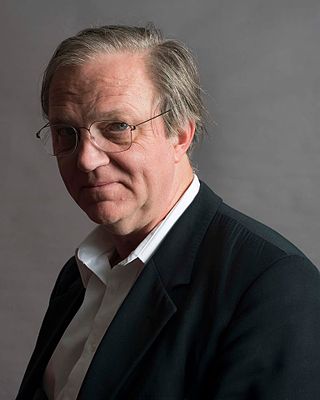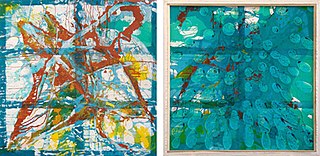Related Research Articles

En plein air, or plein air painting, is the act of painting outdoors.

Alex Katz is an American figurative artist known for his paintings, sculptures, and prints.
Philip Pearlstein is an American painter best known for Modernist Realism nudes. Cited by critics as the preeminent figure painter of the 1960s to 2000s, he led a revival in realist art. He is a Distinguished Professor Emeritus with paintings in the collections of over 70 public art museums.
Neil Gavin Welliver was an American-born modern artist, best known for his large-scale landscape paintings inspired by the deep woods near his home in Maine. One of his sons, Titus Welliver, later became a successful actor.

Robert Storr is an American curator, critic, painter, and writer.

Yvonne Jacquette is an American painter and printmaker known in particular for her depictions of aerial landscapes, especially her low-altitude and oblique aerial views of cities or towns, often painted using a distinctive, pointillistic technique. She is currently represented by DC Moore Gallery, New York.

Thomas Pollock Anshutz was an American painter and teacher. Known for his portraiture and genre scenes, Anshutz was a co-founder of The Darby School. One of Thomas Eakins's most prominent students, he succeeded Eakins as director of drawing and painting classes at the Pennsylvania Academy of Fine Arts.
Lois Dodd is an American painter. Dodd was a key member of New York's postwar art scene. She played a large part and was involved in the wave of modern artists including Alex Katz and Yvonne Jacquette who explored the coast of Maine in the latter half of the 20th century.

The Parrish Art Museum is an art museum designed by Herzog & de Meuron Architects and located in Water Mill, New York, whereto it moved in 2012 from Southampton Village. The museum focuses extensively on work by artists from the artist colony of the South Shore and North Shore.
John Button was an American artist, well known for his city-scapes. Educated at the University of California, Berkeley then moved to New York City in the early 1950s. He became friends with Fairfield Porter and Frank O'Hara and assumed his part in the New York School of Painters and Poets.
David Reed is a contemporary American conceptual and visual artist.
The contemporary realism movement is a worldwide style of painting which came into existence c. 1960s and early 1970s. Featuring a straightforward approach to representation practiced by artists such as Philip Pearlstein, Alex Katz, Jack Beal and Neil Welliver. The movement refers to figurative art works created in a natural yet highly objective style. Today the term Contemporary Realism encompasses all post-1970 sculptors and painters whose discipline is representational art, where the object is to portray the "real" and not the "ideal".

Greg Lindquist is an American artist, painter and sculptor based in New York City.
David Cohen is an American art critic, art historian, curator and publisher. He is the editor of artcritical.com, which he founded in 2001. Cohen is also the organizer and moderator of The Review Panel, an ongoing public discussion forum which he launched in 2004, and has been hosted by the National Academy Museum and School and the Pennsylvania Academy of the Fine Arts. He teaches at Pratt Institute, the Pennsylvania Academy of the Fine Arts, the Fashion Institute of Technology and other institutions.
David Christopher Newton was an American sculptor, painter, printmaker, draftsman, and college art teacher. Newton was born in 1953 in Oakland, California. He lived and worked in California, New York, Massachusetts, Rhode Island and North Carolina with his wife Suzanne McBride Newton. He died in 2011 after battling colon and liver cancer.

Tobi Kahn is an American painter and sculptor. Kahn lives and works in New York City and is on the faculty at the School of Visual Arts.

Robert Beck is an American painter and writer. He is best known for his plein air paintings of scenes in and around Bucks County, Pennsylvania ; Jonesport, Maine; and New York City, typically in multiple-painting series.

Dona Nelson is an American painter, best known for immersive, gestural, primarily abstract works employing unorthodox materials, processes and formats to disrupt conventional notions of painting and viewership. A 2014 New Yorker review observed, "Nelson gives notice that she will do anything, short of burning down her house to bully painting into freshly spluttering eloquence." Since 2002, long before it became a more common practice, Nelson has produced free-standing, double-sided paintings that create a more complex, conscious viewing experience. According to New York Times critic Roberta Smith, Nelson has dodged the burden of a "superficially consistent style," sustained by "an adventuresome emphasis on materials" and an athletic approach to process that builds on the work of Jackson Pollock. Writers in Art in America and Artforum credit her experimentation with influencing a younger generation of painters exploring unconventional techniques with renewed interest. Discussing one of Nelson's visceral, process-driven works, curator Klaus Kertess wrote, the paint-soaked "muslin is at once the tool, the medium, and the made."

Elizabeth Bradford is an American artist living in Davidson, North Carolina, best known for her large-scale paintings of landscapes. Her works have been widely exhibited throughout the southeastern United States and are collected in museums and collections, both private and corporate, across the country.

Louise Belcourt is a Canadian-American artist based in New York, known for elusive, largely abstract paintings that blend modernist formal play, a commitment to the physical world, and a visual language that shifts between landscape and the body, architecture and geometric form. New York Times critic Ken Johnson writes of her earlier work, "balancing adroitly between Color Field abstraction and Pop-style representation, Ms. Belcourt's paintings invite meditation on the perceptual, the conceptual and how our minds construct the world." Describing her later evolution, David Brody writes in Artcritical, "Hard-nosed Canadian empiricism and Brooklyn grit seem to combine in Belcourt’s work to undermine stylistic stasis."
References
- ↑ "He like jam-ups of culture and nature, where practical human uses overlap with indifferent geology and shaggy flora--he is the bard of weeds." Peter Schjeldahl, The New Yorker, quoted by Schwartz, Sanford; Storr, Robert, and Downes, Rackstraw. Rackstraw Downes. Princeton University Press, April 2005.
- ↑ Schwartz, Sanford, et al., 2005, page 175.
- ↑ "RACKSTRAW DOWNES: In Focus". The Brooklyn Rail. Retrieved 20 November 2018.
- ↑ "RACKSTRAW DOWNES: Onsite Paintings, 1972–2008". The Brooklyn Rail. Retrieved 20 November 2018.
- ↑ Cohen, David, Gallery Going, The New York Sun
- ↑ Schwartz, Sanford, et al., 2005, page 72.
- 1 2 3 , "Rendering the Landscape Less Traveled By," Ken Johnson, July 15, 2009, New York Times.
- ↑ , "Art Tussle in the Hamptons: The Tony Parrish Museum Is Leaving Town on Bad Terms," W. M. Akers, June 22, 2010, New York Observer.